Life Sciences Complex
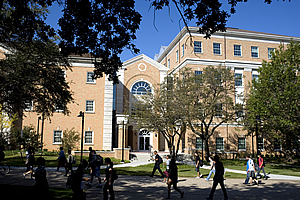 The Life Sciences Complex is a world-class research and teaching facility for biochemistry
and molecular biology, developmental physiology and genetics, and plant science. It
features more than 176,000 square feet of state-of-the-art labs, classrooms, offices,
meeting rooms, and communal spaces.
The Life Sciences Complex is a world-class research and teaching facility for biochemistry
and molecular biology, developmental physiology and genetics, and plant science. It
features more than 176,000 square feet of state-of-the-art labs, classrooms, offices,
meeting rooms, and communal spaces.
The complex's new $40 million, 87,000 square foot B Wing is a modern research facility with open labs that promote collaboration between student and faculty researchers in different disciplines.
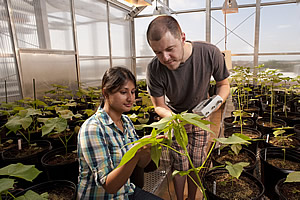
The new research space includes four rooftop greenhouses providing 1,800 square feet of climate-controlled space where biochemists and molecular biologists perform world-changing research, such as engineering crops so that fewer environmentally dangerous pesticides are needed and better fortify existing foods such as rice with more minerals and nutrients.
The wing also contains an aquatics lab where researchers study a wide range of human health issues, from blood clots and oxygen deprivation to aging, diabetes and cancer. The lab is one of the nation's largest and most sophisticated university aquatics labs, containing more than 2,500 tanks and tens of thousands of saltwater and freshwater fish.
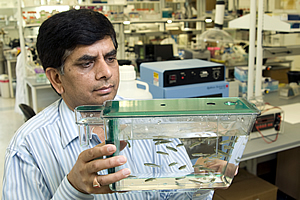
The design and construction of the B Wing were tailored to the exacting LEED (Leadership in Energy and Environmental Design) Gold Certification standards. The building's environmental-friendly features include:
- Bicycle racks and a designated area for showering and changing to encourage walking, bicycling or jogging to work.
- Conservation of existing natural areas and restoration of damaged areas to provide habitat and promote biodiversity.
- Native or adaptive vegetation that needs half the amount of water that traditional landscaping requires.
- Efficient irrigation system that collects and reuses rainwater.
- Low-flow plumbing fixtures that use 30 percent less water than traditional fixtures
Environmental Education, Science, and Technology Building
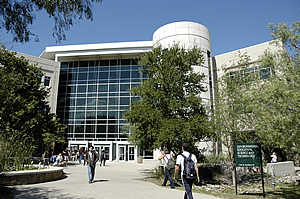 The Environmental Education, Science, and Technology Building (EESAT) is a 117,000
square foot environmentally friendly facility providing lab, classroom, office, and
exhibit facilities for UNT's Environmental Science programs, the Institute of Applied
Science, and the Elm Fork Education Center.
The Environmental Education, Science, and Technology Building (EESAT) is a 117,000
square foot environmentally friendly facility providing lab, classroom, office, and
exhibit facilities for UNT's Environmental Science programs, the Institute of Applied
Science, and the Elm Fork Education Center.
Water Research Field Station and Artificial Stream Facility
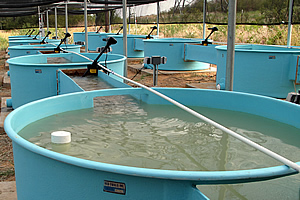
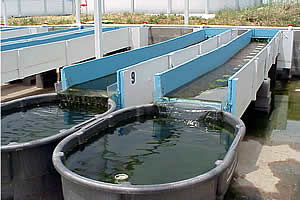 The Water Research Field Station (WRFS) and the Artificial Stream Facility are two
of the few facilities in the nation designed to assess, under field conditions, the
effects of new chemicals and pesticides on aquatic ecosystems prior to their use in
the general environment. The Water Research Field Station consists of 48 aquatic testing
ponds of 0.1 acre each and 52 1,000- and 10,000-liter microcosms. The Artificial Stream
Facility has 12 replicate five-meter streams, each capable of being colonized by aquatic
species. The WRFS is specifically designed to assess the impacts of agrichemicals
on aquatic populations and communities before they are used in the general environment.
The field station and stream facility are supported on campus by a biological and
residue analysis laboratory with state-of-the-art equipment such as computer interfaced
gas chromatographs.
The Water Research Field Station (WRFS) and the Artificial Stream Facility are two
of the few facilities in the nation designed to assess, under field conditions, the
effects of new chemicals and pesticides on aquatic ecosystems prior to their use in
the general environment. The Water Research Field Station consists of 48 aquatic testing
ponds of 0.1 acre each and 52 1,000- and 10,000-liter microcosms. The Artificial Stream
Facility has 12 replicate five-meter streams, each capable of being colonized by aquatic
species. The WRFS is specifically designed to assess the impacts of agrichemicals
on aquatic populations and communities before they are used in the general environment.
The field station and stream facility are supported on campus by a biological and
residue analysis laboratory with state-of-the-art equipment such as computer interfaced
gas chromatographs.
Confocal Microscope Laboratory
The Biology department has two confocal microscopes that are located in the Life Sciences
Building. These microscopes can be used by all faculty members and their researchers.
They are organized as part of the Confocal Microscope Laboratory.